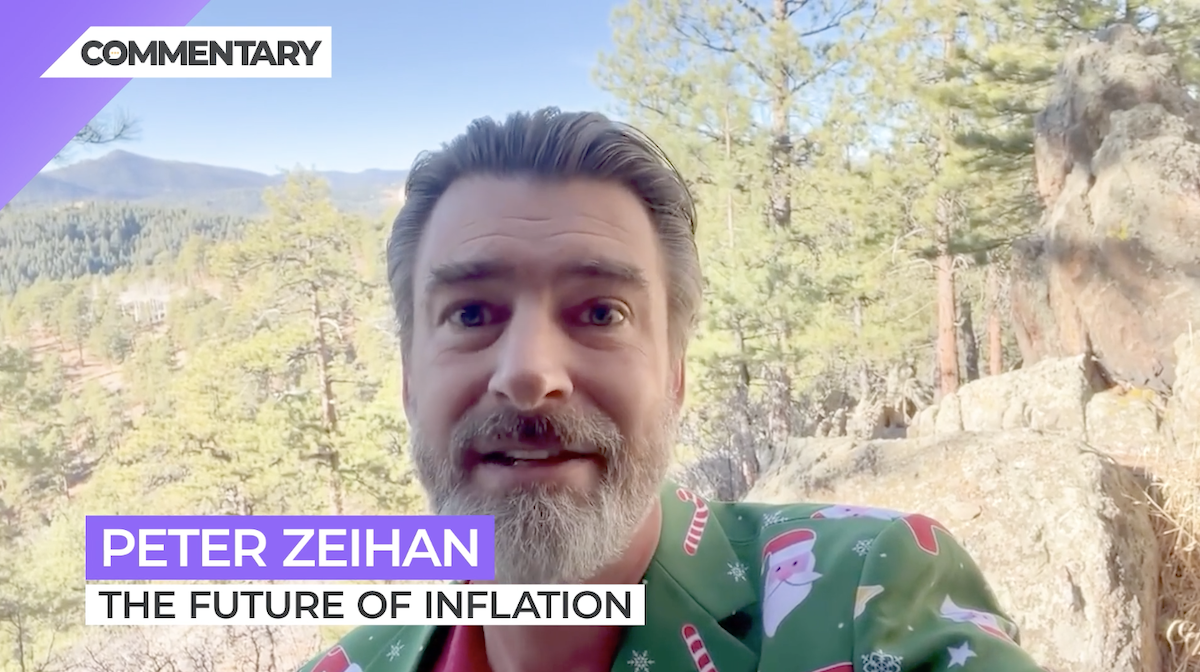
Commentary
-
Our commentary partners will help you reach your own conclusions on complex topics.
Hey everyone Peter Zeihan here and hello from Colorado where we are edging into December and it is still 60 degrees, because you know, mountains.
Now a lot of people in a lot of places been blah blah blah about how inflation is getting out of control, and I thought it would be good to put things into a little perspective both from a good and a bad point of view.
So first, we kind of need to get a grip. People are talking about how inflation is the highest it’s been in 30, 40 years and that is true.
What people are not talking about is why inflation has been so abnormally low for so long. In most of these years, inflation never touched three percent. We’ve only gone above five percent a couple of times, and so having six percent inflation seems like a disaster. But if you remember back to the early 80s and before this was the norm, so it’s not so much what changed now, but what changed 30 40 years ago.
Well there’s three things that are going on.
First, food production. Since the 1980s, total agricultural output in the United States has increased by over half, and in the 1980s, the United States was already the world’s largest producer and exporter of food stuffs. So what for most countries is the single most important aspect of inflation, food prices, has never really been an issue here.
Second, the shale revolution. It started in 2004. We applied a new series of technologies to energy reproduction. And now the United States has the lowest energy prices in the world. Not just in absolute terms but per unit of economic output.
That’s all because of technological advances and production that is local, kind of like with food production. So the second biggest aspect of inflation that has caused problems for countries since the dawn of time is also not a major concern here.
So what’s the third one? Well in a word, globalization.
Two words: globalization and China.
The global order did a lot of things, but in making this safe… making the world’s oceans safe for everyone, it allowed an economic player to interface with any raw materials in any end market, and the Chinese could do so at scale.
So they had a demographic moment. They had a financial system that encouraged overproduction. They had global and regional and national economies of scale, and they had access to every consumer market in the world, most notably the biggest one, in the United States.
That meant that the cost of manufactured goods steadily went down for 40 years and things like electronics and computing in terms of their productivity are less than one-fifth the price of what they were 30 and 40 years ago.
Well the first two trends, energy and food, those aren’t changing. So for the United States, what is traditionally the biggest problem everywhere else in the world is just not a problem… except for maybe in the short term with some hiccups.
But the consumer goods action issue, the manufactured goods issue, that’s all going away.
The Chinese financial system is breaking apart. Chinese demographic movement which gave them oodles of low-cost labor for decades is now over, and they have the fastest appreciating labor costs in the world.
And the Americans are backing away from globalization, meaning that the Chinese have to take care of their own material inputs, their own energy inputs, and find their own markets. And there just isn’t that possibility anywhere in the world at the scale that they need, which means that global supply chains for every manufactured product needs to change.
Now here in the United States we can already produce all of these products at a lower price point.
Our labor is more productive, our food and energy inputs are lower; transport to end consumers is negligible, but you have to build the industrial plant first and you don’t do that in a year.
Which means that the biggest dis-inflationary aspect of the global system that we have seen for the last 30 years, the reason why inflation has been so low for so long, the participation of China is coming to an end.
And the adjustment to our new normal will take a few years, and we’ll see inflation inflation inflation as we build out that plant and as every supply chain that we’ve become dependent upon, requires complete rethreading.
That is the future of inflation and that is the story for the next five years.
-
Hurricane Helene hits US coast, Appalachia and beyond
Hurricane Helene hit Florida and Georgia overnight between Sept. 26 and 27 as a Category 4 hurricane, and accompanying storms will continue reaching deeper into the continental United States today. Dangerous flash flooding from the hurricane, known as storm surge, was some of the worst flooding that the Tampa Bay area has ever seen, and… -
Israel holds upper hand against Lebanon, Hezbollah and Iran
On Wednesday, Sept. 25, Hezbollah launched a ballistic missile at Tel Aviv in retaliation for Israel’s explosive pager attack that blew up devices across Lebanon. Although Israel’s defense systems intercepted the surface-to-surface missile, the attempted strike on Tel Aviv marked a significant escalation by Hezbollah. Since the siege on Gaza began, shortly after the Oct. 7, 2023,… -
The Sinaloa Cartel civil war
Fears of a civil war within the Sinaloa Cartel are growing as violence between competing factions within the cartel continues. The Mexican Army has dispatched around 600 elite troops to Sinaloa to help quell those fears, in addition to roughly 2,200 regular soldiers and National Guard. Watch the above video as Straight Arrow News contributor… -
New Ukrainian weapons hit Russia where it hurts
Ukrainian drones struck a major Russian ammunition depot, triggering a massive explosion that was captured on camera. According to the Ukrainian military, 2,000 tons of munitions had arrived at the depot before the attack. Over the past two years, Ukraine has significantly increased its domestic drone production, allowing it to scale up attacks on military… -
Weighing social costs vs. economic benefits on immigration
Global human migration is one of the defining elements of our current historical era, according to the United Nations. Migrants face both the incentives to leave — forced out by climate change, crime and corruption, extreme poverty or violence — and incentives for where to go, based on available job opportunities and so on. Migration…
Latest Stories
-
 Reuters
Reuters
LeBron James first to reach 50k points, shows no signs of slowing down
-
 Getty Images
Getty Images
Trump admin seeking to sell nearly 450 vacant, underused federal spaces
-
 Getty Images
Getty Images
US stops intelligence aid to Ukraine amid overnight Russian attacks
-
 Getty Images
Getty Images
Gene Hackman’s dead dog misidentified as details continue unfolding
-
 Getty Images
Getty Images
Sexual violence used as war tactic against Sudanese children: UNICEF
Popular Opinions
-
In addition to the facts, we believe it’s vital to hear perspectives from all sides of the political spectrum.
Latest Opinions
In addition to the facts, we believe it’s vital to hear perspectives from all sides of the political spectrum. We hope these different voices will help you reach your own conclusions.
The opinions published in this section are solely those of the contributors and do not reflect the views of Straight Arrow News.





















Latest Commentary
We know it is important to hear from a diverse range of observers on the complex topics we face and believe our commentary partners will help you reach your own conclusions.
The commentaries published in this section are solely those of the contributors and do not reflect the views of Straight Arrow News.
Dr. Frank Luntz
Pollster and Political Analyst‘Biased’: What Americans think of ‘mainstream media’
‘Getting rid of them’: Americans discuss Trump and immigration
‘Woke’: Why some Biden 2020 voters backed Trump in 2024